Accounting & Financial Management: Ratio Analysis of Two Banks
VerifiedAdded on 2020/05/04
|7
|1525
|84
Report
AI Summary
This report presents a detailed analysis of the financial performance of ANZ and Commonwealth Banks from 2014 to 2016 using various financial ratios. The analysis covers profitability ratios (Net Profit Ratio, Return on Assets), efficiency ratios (Fixed Asset Turnover Ratio, Asset Turnover Ratio), liquidity ratios (Current Ratio, Quick Ratio), financial gearing ratios (Debt Equity Ratio, Debt Ratio), and investment analysis ratios (Earnings Per Share, Dividend per Share). The report calculates and compares these ratios for both banks, providing insights into their financial health, efficiency in asset utilization, liquidity positions, capital structure, and investment attractiveness. The findings suggest that Commonwealth Bank generally demonstrated stronger financial performance during the analyzed period, particularly in profitability and investment returns, while ANZ Bank showed declining trends in several key ratios. The report concludes with a discussion of the implications of these findings for stakeholders, including investors and management. The report also includes the financial data used for the calculations along with the references used.
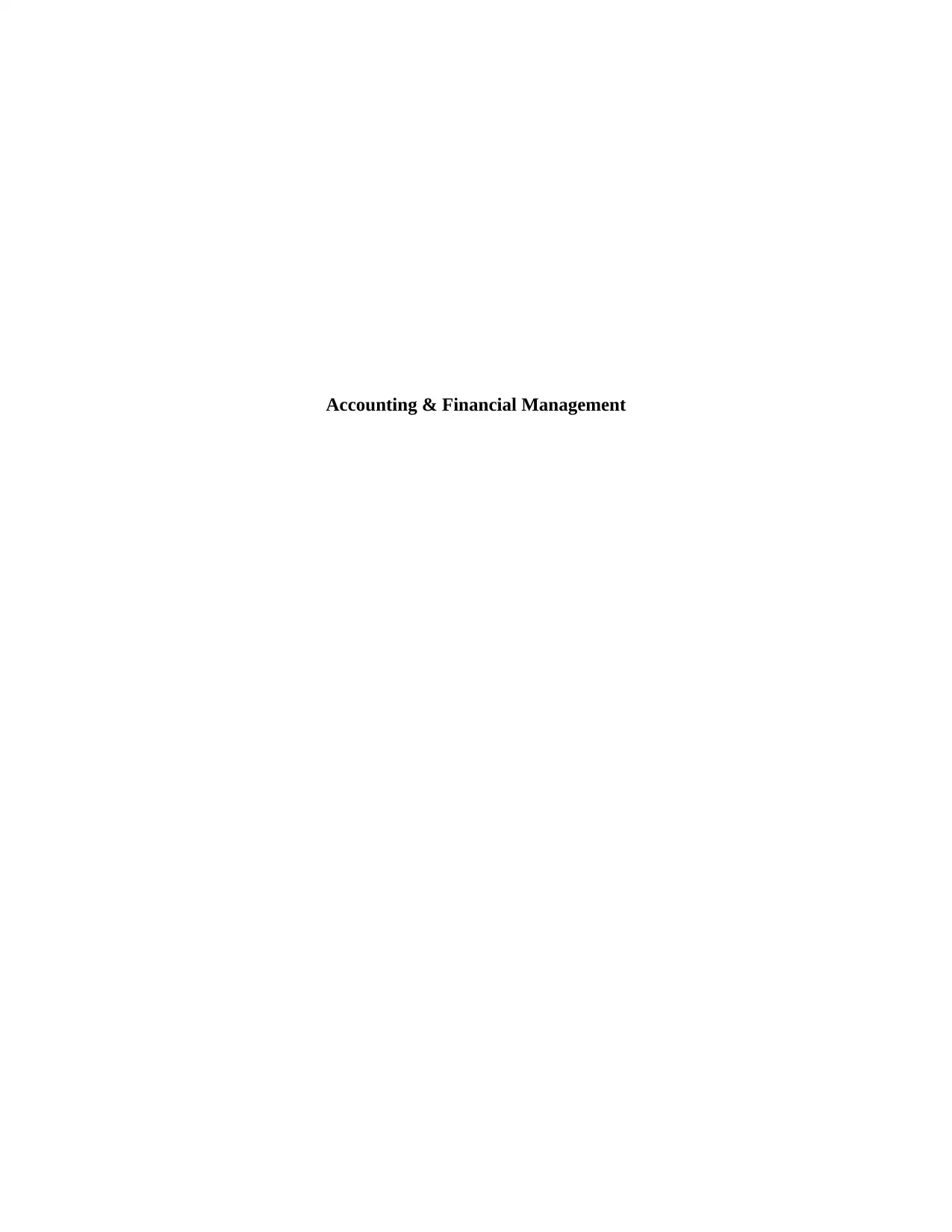
Accounting & Financial Management
Paraphrase This Document
Need a fresh take? Get an instant paraphrase of this document with our AI Paraphraser

C. Ratio Analysis
Profitability Ratios
The profitability ratios are calculated for analyzing the revenue generated by a business
entity in comparison to the expenses incurred. The ratios examined for measuring the
profitability of ANZ and Commonwealth bank are as follows:
Net Profit ratio: The net profit ratio depicts the percentage of profit realized from the business
operations after meeting all the operating expenses, interest expenses and taxes. It is calculated
through the help of following formula:
Net Profit=Profit after tax/Net Sales
Return on Assets: It depicts the profit gained by a business entity through the use of its total
assets (Atrill, McLaney and Harvey, 2014). It is calculated as:
Return on Assets (ROA) =Net Income/Average Total Assets
The profitability ratios of ANZ and Commonwealth Bank as calculated are as follows:
Profitability Ratio 2014 2015 2016
Net Profit Ratio ANZ 36.26% 35.56% 27.81%
Commonwealth 33.50% 33.56% 33.56%
Return on Assets ANZ 0.94% 0.84% 0.62%
Commonwealth 1.09% 1.04% 0.99%
As depicted form the above table, the net profit ratio of ANZ have shows a decreasing
trend from 2014-2016 while of Commonwealth have shown an increasing trend for the same
period. On the other hand, the ROA of both ANZ and commonwealth bank is declining from
2014-2016. Thus, it can be said that Commonwealth bank has realized larger profits in the recent
years as compared to ANZ (ANZ : Annual Report, 2015).
Efficiency Ratios:
The efficiency ratios depict the ability of a business entity to realize sales from the
effective use of its assets. The efficiency ratios analyzed for ANZ and Commonwealth are as
follows:
Fixed Turnover Ratio: It depicts the use of fixed assets by a business entity to generate sales and
is calculated as:
Fixed Asset Turnover Ratio=Net Sales/Average Fixed assets
Profitability Ratios
The profitability ratios are calculated for analyzing the revenue generated by a business
entity in comparison to the expenses incurred. The ratios examined for measuring the
profitability of ANZ and Commonwealth bank are as follows:
Net Profit ratio: The net profit ratio depicts the percentage of profit realized from the business
operations after meeting all the operating expenses, interest expenses and taxes. It is calculated
through the help of following formula:
Net Profit=Profit after tax/Net Sales
Return on Assets: It depicts the profit gained by a business entity through the use of its total
assets (Atrill, McLaney and Harvey, 2014). It is calculated as:
Return on Assets (ROA) =Net Income/Average Total Assets
The profitability ratios of ANZ and Commonwealth Bank as calculated are as follows:
Profitability Ratio 2014 2015 2016
Net Profit Ratio ANZ 36.26% 35.56% 27.81%
Commonwealth 33.50% 33.56% 33.56%
Return on Assets ANZ 0.94% 0.84% 0.62%
Commonwealth 1.09% 1.04% 0.99%
As depicted form the above table, the net profit ratio of ANZ have shows a decreasing
trend from 2014-2016 while of Commonwealth have shown an increasing trend for the same
period. On the other hand, the ROA of both ANZ and commonwealth bank is declining from
2014-2016. Thus, it can be said that Commonwealth bank has realized larger profits in the recent
years as compared to ANZ (ANZ : Annual Report, 2015).
Efficiency Ratios:
The efficiency ratios depict the ability of a business entity to realize sales from the
effective use of its assets. The efficiency ratios analyzed for ANZ and Commonwealth are as
follows:
Fixed Turnover Ratio: It depicts the use of fixed assets by a business entity to generate sales and
is calculated as:
Fixed Asset Turnover Ratio=Net Sales/Average Fixed assets
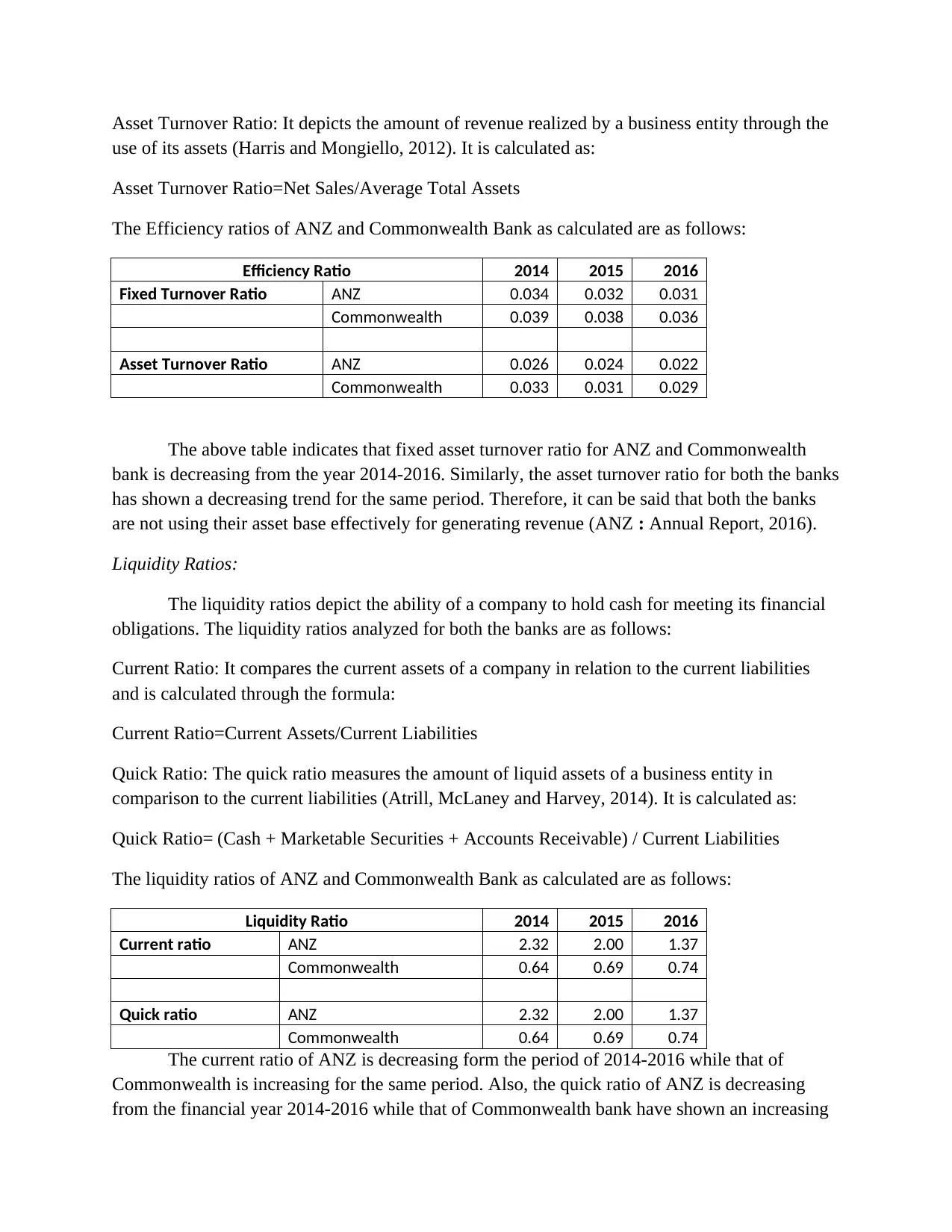
Asset Turnover Ratio: It depicts the amount of revenue realized by a business entity through the
use of its assets (Harris and Mongiello, 2012). It is calculated as:
Asset Turnover Ratio=Net Sales/Average Total Assets
The Efficiency ratios of ANZ and Commonwealth Bank as calculated are as follows:
Efficiency Ratio 2014 2015 2016
Fixed Turnover Ratio ANZ 0.034 0.032 0.031
Commonwealth 0.039 0.038 0.036
Asset Turnover Ratio ANZ 0.026 0.024 0.022
Commonwealth 0.033 0.031 0.029
The above table indicates that fixed asset turnover ratio for ANZ and Commonwealth
bank is decreasing from the year 2014-2016. Similarly, the asset turnover ratio for both the banks
has shown a decreasing trend for the same period. Therefore, it can be said that both the banks
are not using their asset base effectively for generating revenue (ANZ : Annual Report, 2016).
Liquidity Ratios:
The liquidity ratios depict the ability of a company to hold cash for meeting its financial
obligations. The liquidity ratios analyzed for both the banks are as follows:
Current Ratio: It compares the current assets of a company in relation to the current liabilities
and is calculated through the formula:
Current Ratio=Current Assets/Current Liabilities
Quick Ratio: The quick ratio measures the amount of liquid assets of a business entity in
comparison to the current liabilities (Atrill, McLaney and Harvey, 2014). It is calculated as:
Quick Ratio= (Cash + Marketable Securities + Accounts Receivable) / Current Liabilities
The liquidity ratios of ANZ and Commonwealth Bank as calculated are as follows:
Liquidity Ratio 2014 2015 2016
Current ratio ANZ 2.32 2.00 1.37
Commonwealth 0.64 0.69 0.74
Quick ratio ANZ 2.32 2.00 1.37
Commonwealth 0.64 0.69 0.74
The current ratio of ANZ is decreasing form the period of 2014-2016 while that of
Commonwealth is increasing for the same period. Also, the quick ratio of ANZ is decreasing
from the financial year 2014-2016 while that of Commonwealth bank have shown an increasing
use of its assets (Harris and Mongiello, 2012). It is calculated as:
Asset Turnover Ratio=Net Sales/Average Total Assets
The Efficiency ratios of ANZ and Commonwealth Bank as calculated are as follows:
Efficiency Ratio 2014 2015 2016
Fixed Turnover Ratio ANZ 0.034 0.032 0.031
Commonwealth 0.039 0.038 0.036
Asset Turnover Ratio ANZ 0.026 0.024 0.022
Commonwealth 0.033 0.031 0.029
The above table indicates that fixed asset turnover ratio for ANZ and Commonwealth
bank is decreasing from the year 2014-2016. Similarly, the asset turnover ratio for both the banks
has shown a decreasing trend for the same period. Therefore, it can be said that both the banks
are not using their asset base effectively for generating revenue (ANZ : Annual Report, 2016).
Liquidity Ratios:
The liquidity ratios depict the ability of a company to hold cash for meeting its financial
obligations. The liquidity ratios analyzed for both the banks are as follows:
Current Ratio: It compares the current assets of a company in relation to the current liabilities
and is calculated through the formula:
Current Ratio=Current Assets/Current Liabilities
Quick Ratio: The quick ratio measures the amount of liquid assets of a business entity in
comparison to the current liabilities (Atrill, McLaney and Harvey, 2014). It is calculated as:
Quick Ratio= (Cash + Marketable Securities + Accounts Receivable) / Current Liabilities
The liquidity ratios of ANZ and Commonwealth Bank as calculated are as follows:
Liquidity Ratio 2014 2015 2016
Current ratio ANZ 2.32 2.00 1.37
Commonwealth 0.64 0.69 0.74
Quick ratio ANZ 2.32 2.00 1.37
Commonwealth 0.64 0.69 0.74
The current ratio of ANZ is decreasing form the period of 2014-2016 while that of
Commonwealth is increasing for the same period. Also, the quick ratio of ANZ is decreasing
from the financial year 2014-2016 while that of Commonwealth bank have shown an increasing
⊘ This is a preview!⊘
Do you want full access?
Subscribe today to unlock all pages.

Trusted by 1+ million students worldwide
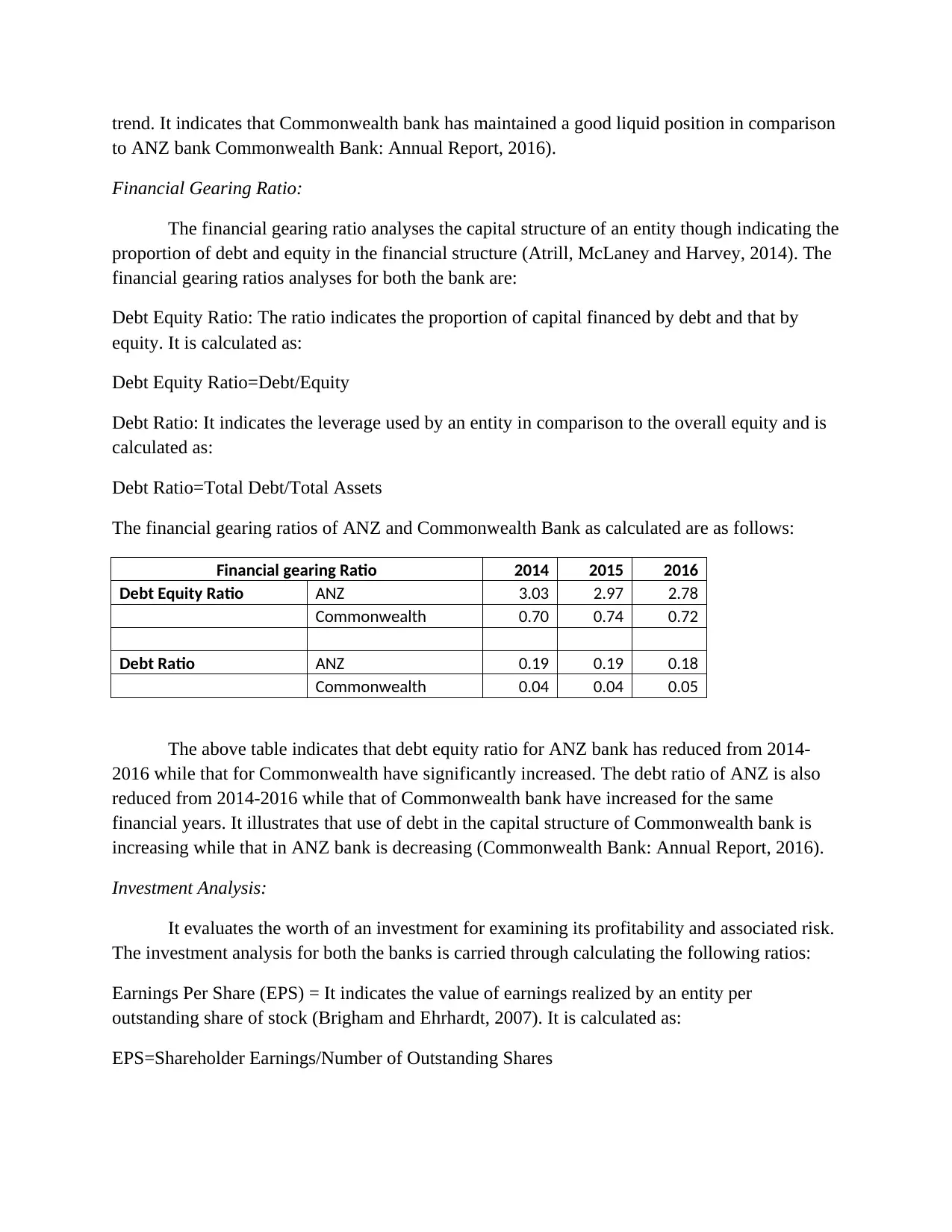
trend. It indicates that Commonwealth bank has maintained a good liquid position in comparison
to ANZ bank Commonwealth Bank: Annual Report, 2016).
Financial Gearing Ratio:
The financial gearing ratio analyses the capital structure of an entity though indicating the
proportion of debt and equity in the financial structure (Atrill, McLaney and Harvey, 2014). The
financial gearing ratios analyses for both the bank are:
Debt Equity Ratio: The ratio indicates the proportion of capital financed by debt and that by
equity. It is calculated as:
Debt Equity Ratio=Debt/Equity
Debt Ratio: It indicates the leverage used by an entity in comparison to the overall equity and is
calculated as:
Debt Ratio=Total Debt/Total Assets
The financial gearing ratios of ANZ and Commonwealth Bank as calculated are as follows:
Financial gearing Ratio 2014 2015 2016
Debt Equity Ratio ANZ 3.03 2.97 2.78
Commonwealth 0.70 0.74 0.72
Debt Ratio ANZ 0.19 0.19 0.18
Commonwealth 0.04 0.04 0.05
The above table indicates that debt equity ratio for ANZ bank has reduced from 2014-
2016 while that for Commonwealth have significantly increased. The debt ratio of ANZ is also
reduced from 2014-2016 while that of Commonwealth bank have increased for the same
financial years. It illustrates that use of debt in the capital structure of Commonwealth bank is
increasing while that in ANZ bank is decreasing (Commonwealth Bank: Annual Report, 2016).
Investment Analysis:
It evaluates the worth of an investment for examining its profitability and associated risk.
The investment analysis for both the banks is carried through calculating the following ratios:
Earnings Per Share (EPS) = It indicates the value of earnings realized by an entity per
outstanding share of stock (Brigham and Ehrhardt, 2007). It is calculated as:
EPS=Shareholder Earnings/Number of Outstanding Shares
to ANZ bank Commonwealth Bank: Annual Report, 2016).
Financial Gearing Ratio:
The financial gearing ratio analyses the capital structure of an entity though indicating the
proportion of debt and equity in the financial structure (Atrill, McLaney and Harvey, 2014). The
financial gearing ratios analyses for both the bank are:
Debt Equity Ratio: The ratio indicates the proportion of capital financed by debt and that by
equity. It is calculated as:
Debt Equity Ratio=Debt/Equity
Debt Ratio: It indicates the leverage used by an entity in comparison to the overall equity and is
calculated as:
Debt Ratio=Total Debt/Total Assets
The financial gearing ratios of ANZ and Commonwealth Bank as calculated are as follows:
Financial gearing Ratio 2014 2015 2016
Debt Equity Ratio ANZ 3.03 2.97 2.78
Commonwealth 0.70 0.74 0.72
Debt Ratio ANZ 0.19 0.19 0.18
Commonwealth 0.04 0.04 0.05
The above table indicates that debt equity ratio for ANZ bank has reduced from 2014-
2016 while that for Commonwealth have significantly increased. The debt ratio of ANZ is also
reduced from 2014-2016 while that of Commonwealth bank have increased for the same
financial years. It illustrates that use of debt in the capital structure of Commonwealth bank is
increasing while that in ANZ bank is decreasing (Commonwealth Bank: Annual Report, 2016).
Investment Analysis:
It evaluates the worth of an investment for examining its profitability and associated risk.
The investment analysis for both the banks is carried through calculating the following ratios:
Earnings Per Share (EPS) = It indicates the value of earnings realized by an entity per
outstanding share of stock (Brigham and Ehrhardt, 2007). It is calculated as:
EPS=Shareholder Earnings/Number of Outstanding Shares
Paraphrase This Document
Need a fresh take? Get an instant paraphrase of this document with our AI Paraphraser
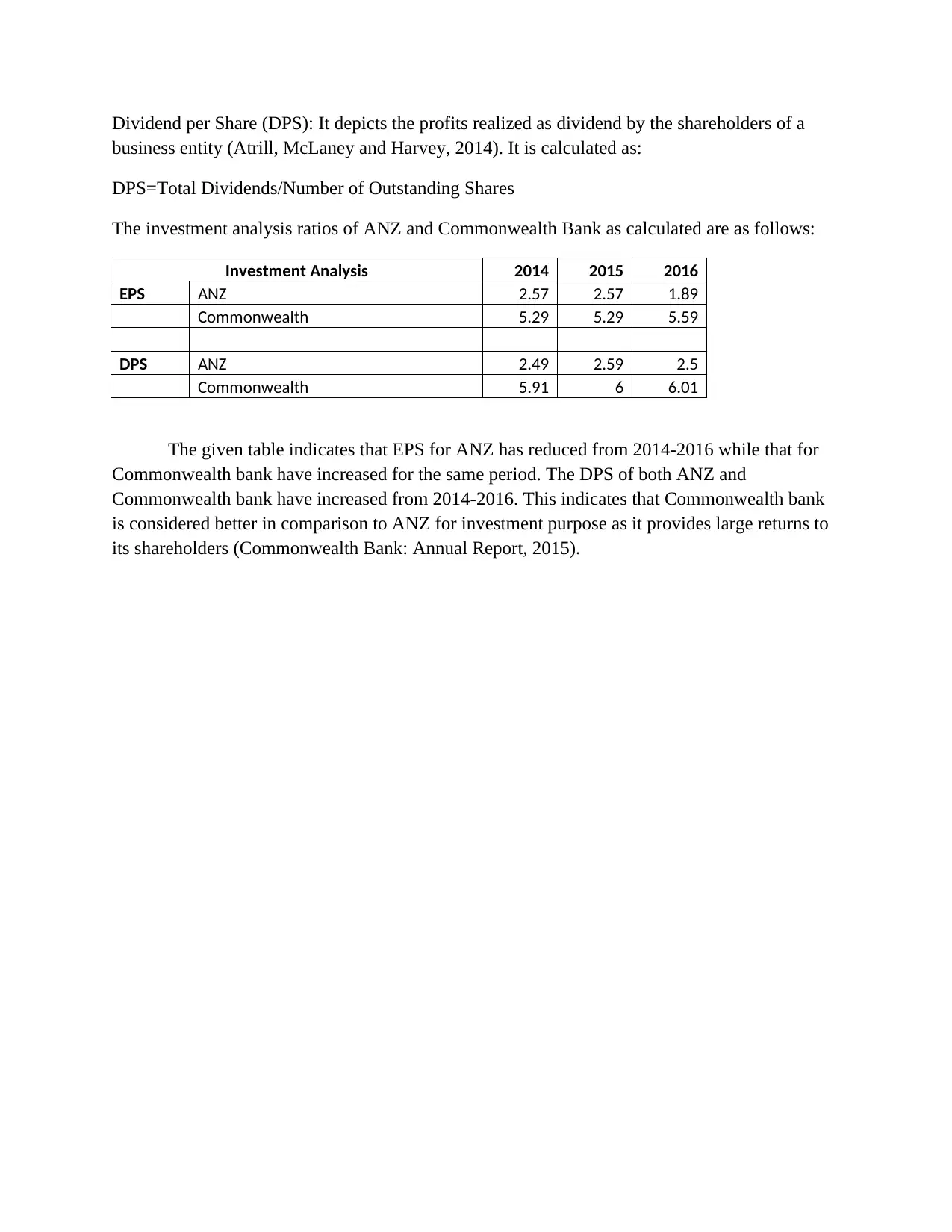
Dividend per Share (DPS): It depicts the profits realized as dividend by the shareholders of a
business entity (Atrill, McLaney and Harvey, 2014). It is calculated as:
DPS=Total Dividends/Number of Outstanding Shares
The investment analysis ratios of ANZ and Commonwealth Bank as calculated are as follows:
Investment Analysis 2014 2015 2016
EPS ANZ 2.57 2.57 1.89
Commonwealth 5.29 5.29 5.59
DPS ANZ 2.49 2.59 2.5
Commonwealth 5.91 6 6.01
The given table indicates that EPS for ANZ has reduced from 2014-2016 while that for
Commonwealth bank have increased for the same period. The DPS of both ANZ and
Commonwealth bank have increased from 2014-2016. This indicates that Commonwealth bank
is considered better in comparison to ANZ for investment purpose as it provides large returns to
its shareholders (Commonwealth Bank: Annual Report, 2015).
business entity (Atrill, McLaney and Harvey, 2014). It is calculated as:
DPS=Total Dividends/Number of Outstanding Shares
The investment analysis ratios of ANZ and Commonwealth Bank as calculated are as follows:
Investment Analysis 2014 2015 2016
EPS ANZ 2.57 2.57 1.89
Commonwealth 5.29 5.29 5.59
DPS ANZ 2.49 2.59 2.5
Commonwealth 5.91 6 6.01
The given table indicates that EPS for ANZ has reduced from 2014-2016 while that for
Commonwealth bank have increased for the same period. The DPS of both ANZ and
Commonwealth bank have increased from 2014-2016. This indicates that Commonwealth bank
is considered better in comparison to ANZ for investment purpose as it provides large returns to
its shareholders (Commonwealth Bank: Annual Report, 2015).
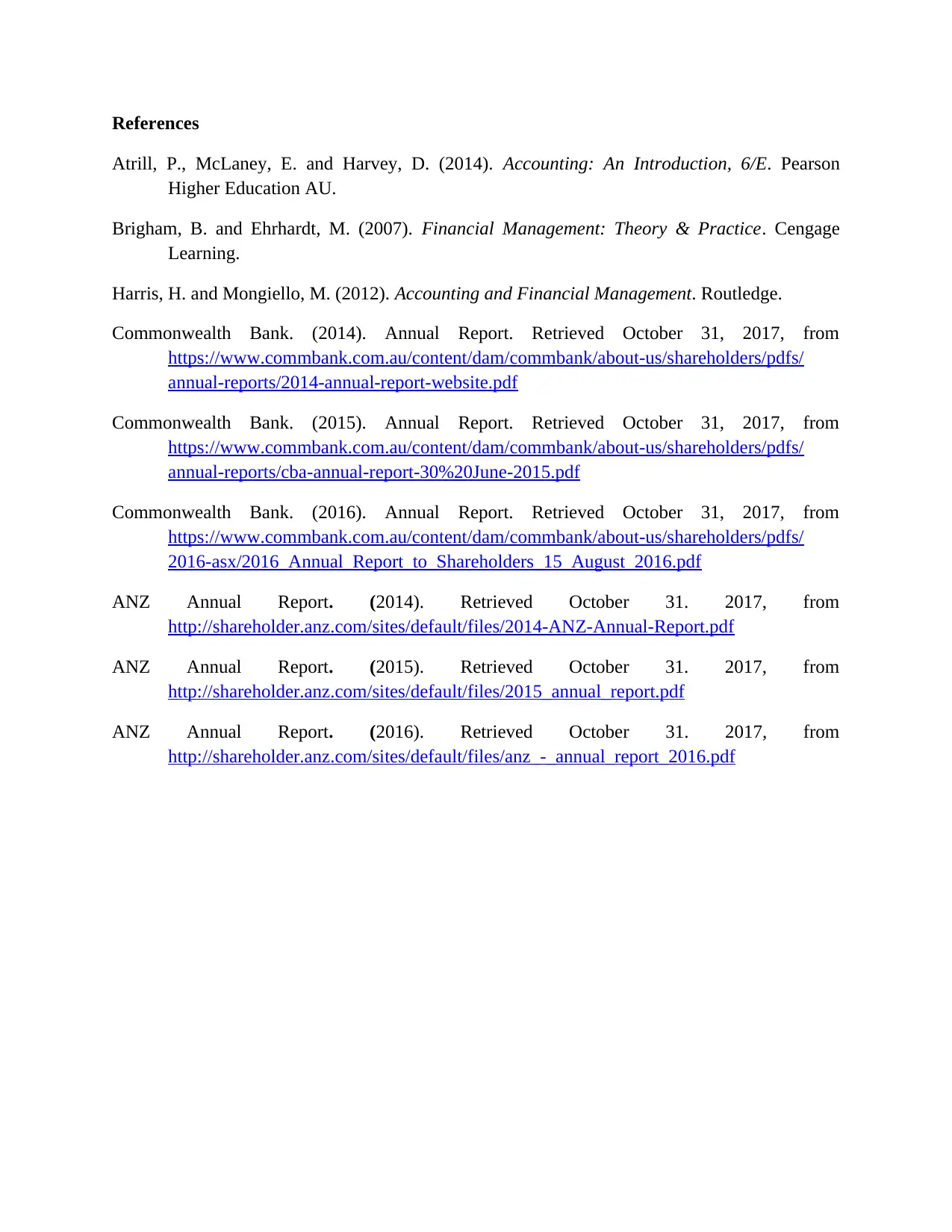
References
Atrill, P., McLaney, E. and Harvey, D. (2014). Accounting: An Introduction, 6/E. Pearson
Higher Education AU.
Brigham, B. and Ehrhardt, M. (2007). Financial Management: Theory & Practice. Cengage
Learning.
Harris, H. and Mongiello, M. (2012). Accounting and Financial Management. Routledge.
Commonwealth Bank. (2014). Annual Report. Retrieved October 31, 2017, from
https://www.commbank.com.au/content/dam/commbank/about-us/shareholders/pdfs/
annual-reports/2014-annual-report-website.pdf
Commonwealth Bank. (2015). Annual Report. Retrieved October 31, 2017, from
https://www.commbank.com.au/content/dam/commbank/about-us/shareholders/pdfs/
annual-reports/cba-annual-report-30%20June-2015.pdf
Commonwealth Bank. (2016). Annual Report. Retrieved October 31, 2017, from
https://www.commbank.com.au/content/dam/commbank/about-us/shareholders/pdfs/
2016-asx/2016_Annual_Report_to_Shareholders_15_August_2016.pdf
ANZ Annual Report. (2014). Retrieved October 31. 2017, from
http://shareholder.anz.com/sites/default/files/2014-ANZ-Annual-Report.pdf
ANZ Annual Report. (2015). Retrieved October 31. 2017, from
http://shareholder.anz.com/sites/default/files/2015_annual_report.pdf
ANZ Annual Report. (2016). Retrieved October 31. 2017, from
http://shareholder.anz.com/sites/default/files/anz_-_annual_report_2016.pdf
Atrill, P., McLaney, E. and Harvey, D. (2014). Accounting: An Introduction, 6/E. Pearson
Higher Education AU.
Brigham, B. and Ehrhardt, M. (2007). Financial Management: Theory & Practice. Cengage
Learning.
Harris, H. and Mongiello, M. (2012). Accounting and Financial Management. Routledge.
Commonwealth Bank. (2014). Annual Report. Retrieved October 31, 2017, from
https://www.commbank.com.au/content/dam/commbank/about-us/shareholders/pdfs/
annual-reports/2014-annual-report-website.pdf
Commonwealth Bank. (2015). Annual Report. Retrieved October 31, 2017, from
https://www.commbank.com.au/content/dam/commbank/about-us/shareholders/pdfs/
annual-reports/cba-annual-report-30%20June-2015.pdf
Commonwealth Bank. (2016). Annual Report. Retrieved October 31, 2017, from
https://www.commbank.com.au/content/dam/commbank/about-us/shareholders/pdfs/
2016-asx/2016_Annual_Report_to_Shareholders_15_August_2016.pdf
ANZ Annual Report. (2014). Retrieved October 31. 2017, from
http://shareholder.anz.com/sites/default/files/2014-ANZ-Annual-Report.pdf
ANZ Annual Report. (2015). Retrieved October 31. 2017, from
http://shareholder.anz.com/sites/default/files/2015_annual_report.pdf
ANZ Annual Report. (2016). Retrieved October 31. 2017, from
http://shareholder.anz.com/sites/default/files/anz_-_annual_report_2016.pdf
⊘ This is a preview!⊘
Do you want full access?
Subscribe today to unlock all pages.

Trusted by 1+ million students worldwide

Appendix
Financial Data for Both the Companies
Particulars
ANZ Bank Commonwealth Bank
2014 2015 2016 2014 2015 2016
Net Profit
$
7,271.00
$
7,493.00
$
5,709.00
$
8,631.00
$
9,063.00
$
9,227.00
Net Revenue
$
20,054.00
$
21,071.00
$
20,529.00
$
25,768.00
$
27,005.00
$
27,497.00
Total Assets
$
772,092.00
$
889,900.00
$
914,869.00
$
791,451.00
$
873,446.00
$
933,078.00
Inventories $ - $ -
$
-
$
-
$
- $ -
Fixed Assets
$
585,537.00
$
657,522.00
$
653,648.00
$
656,862.00
$
708,181.00
$
753,743.00
Current Assets
$
186,555.00
$
232,378.00
$
261,221.00
$
134,589.00
$
165,265.00
$
179,335.00
Current Liabilities
$
80,461.00
$
116,202.00
$
190,992.00
$
209,950.00
$
239,107.00
$
241,181.00
Quick Assets
$
186,555.00
$
232,378.00
$
261,221.00
$
134,589.00
$
165,265.00
$
179,335.00
Shareholder
Equity
$
49,207.00
$
57,247.00
$
57,818.00
$
48,811.00
$
52,431.00
$
60,206.00
Long Term Debt
$
148,897.00
$
170,223.00
$
160,641.00
$
34,338.00
$
38,677.00
$
43,646.00
Earning Per Share
$
2.57
$
2.57
$
1.89
$
5.29
$
5.29
$
5.59
Dividend Per
Share
$
2.49
$
2.59
$
2.50
$
5.91
$
6.00
$
6.01
Financial Data for Both the Companies
Particulars
ANZ Bank Commonwealth Bank
2014 2015 2016 2014 2015 2016
Net Profit
$
7,271.00
$
7,493.00
$
5,709.00
$
8,631.00
$
9,063.00
$
9,227.00
Net Revenue
$
20,054.00
$
21,071.00
$
20,529.00
$
25,768.00
$
27,005.00
$
27,497.00
Total Assets
$
772,092.00
$
889,900.00
$
914,869.00
$
791,451.00
$
873,446.00
$
933,078.00
Inventories $ - $ -
$
-
$
-
$
- $ -
Fixed Assets
$
585,537.00
$
657,522.00
$
653,648.00
$
656,862.00
$
708,181.00
$
753,743.00
Current Assets
$
186,555.00
$
232,378.00
$
261,221.00
$
134,589.00
$
165,265.00
$
179,335.00
Current Liabilities
$
80,461.00
$
116,202.00
$
190,992.00
$
209,950.00
$
239,107.00
$
241,181.00
Quick Assets
$
186,555.00
$
232,378.00
$
261,221.00
$
134,589.00
$
165,265.00
$
179,335.00
Shareholder
Equity
$
49,207.00
$
57,247.00
$
57,818.00
$
48,811.00
$
52,431.00
$
60,206.00
Long Term Debt
$
148,897.00
$
170,223.00
$
160,641.00
$
34,338.00
$
38,677.00
$
43,646.00
Earning Per Share
$
2.57
$
2.57
$
1.89
$
5.29
$
5.29
$
5.59
Dividend Per
Share
$
2.49
$
2.59
$
2.50
$
5.91
$
6.00
$
6.01
1 out of 7
Related Documents
Your All-in-One AI-Powered Toolkit for Academic Success.
+13062052269
info@desklib.com
Available 24*7 on WhatsApp / Email
![[object Object]](/_next/static/media/star-bottom.7253800d.svg)
Unlock your academic potential
Copyright © 2020–2025 A2Z Services. All Rights Reserved. Developed and managed by ZUCOL.





